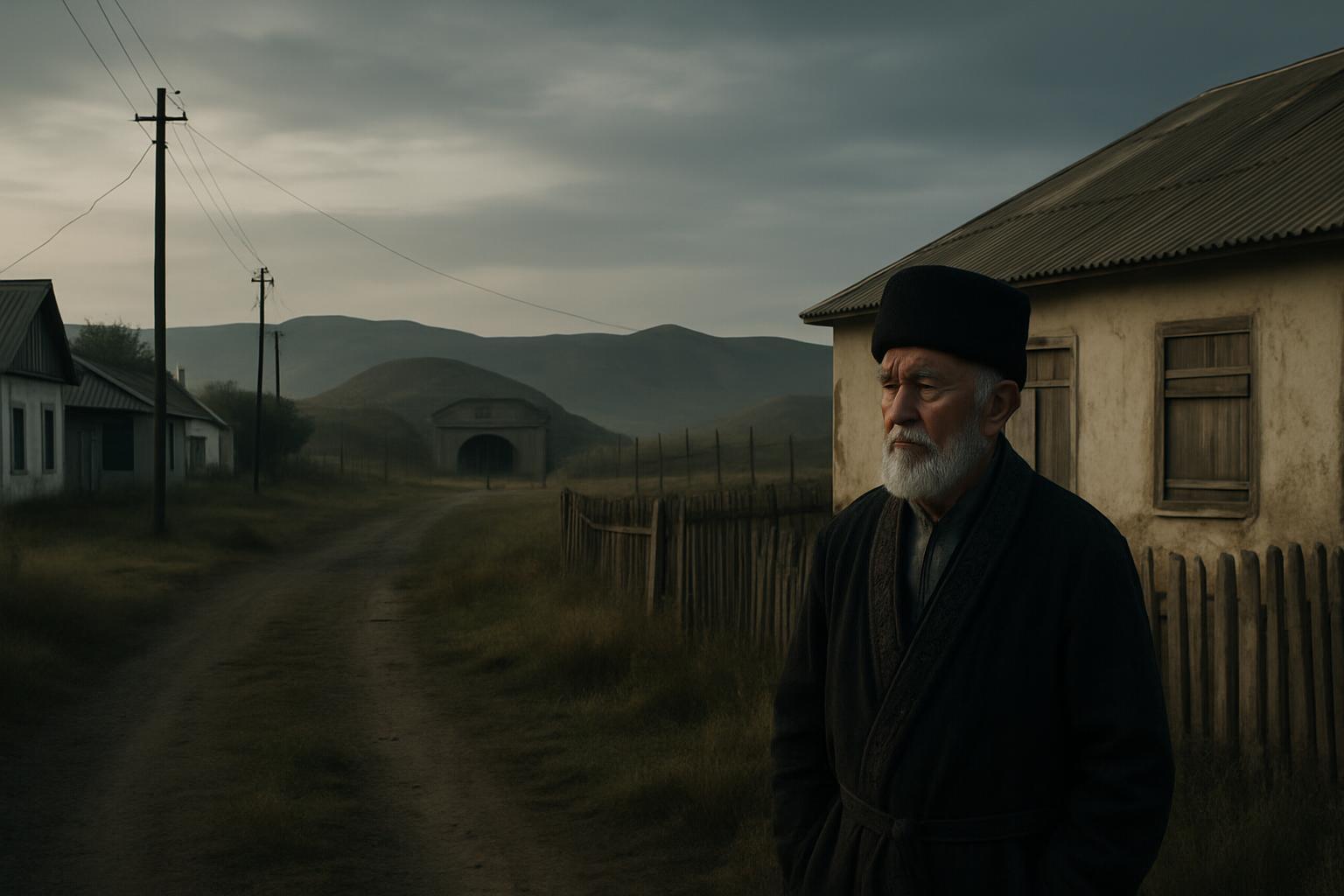High in the vast grasslands of Kazakhstan, small villages once found themselves trapped in a bewildering nightmare. Without warning, scores of villagers would collapse into deep, sudden sleep that could last for days. This strange phenomenon gave rise to fear, speculation, and a medical mystery that held the world in its grip. Here’s the story of the Kazakhstan “sleeping sickness” mystery—and the hunt for its cause.
A Sudden Plague of Sleep
The peaceful village of Kalachi, in northern Kazakhstan, was the first to report the puzzling outbreak. It was spring of 2013. Reports trickled in: friends, neighbors, even entire families fell asleep out of nowhere. People would be walking, cooking, or tending animals, only to slip into a deep sleep they could not fight. Some of these episodes lasted a few minutes, but others stretched into days.
Word spread quickly. Soon, another nearby settlement, Krasnogorsk, began reporting similar cases. By the end of 2013, hundreds of people in these two villages had suffered sudden bouts of overwhelming sleepiness. The condition did not discriminate—it struck men, women, and children alike. Doctors saw children falling asleep at school and farmers toppling from their tractors.
Often, those affected could not remember what happened to them. Some woke confused or frightened. Others suffered strange side effects like vivid hallucinations, memory gaps, headaches, fatigue, dizziness, or even personality changes. In several cases, people had repeated episodes. The mystery only deepened as time went on.
Symptoms Beyond Ordinary Sleep
Unlike simple fatigue, the sleep took on a life of its own. People described it as impossible to resist, like being swept quickly into unconsciousness. Some shared stories of waking up after two or even six days, unable to recall any dreams or events during their slumbers. Others awoke feeling weaker than before, with lingering headaches or confusion that lasted for days.
Strikingly, many villagers reported hallucinations. One man described seeing giant horses trotting through his bedroom. Another thought she was talking with relatives long dead. Children told of talking cats and shifting shadows on the ceiling. While hallucinations are not uncommon in extreme exhaustion, the sheer number and vividness of these accounts set them apart.
The mystery sleep sometimes triggered more frightening symptoms. Several villagers suffered partial paralysis, memory loss, or mood swings after waking. A few went on to develop sleep disorders or neurological problems, fearing every nap could turn into another attack.
Daily Life Turned Upside Down
Life in Kalachi and Krasnogorsk changed in the wake of these events. Parents kept children home from school, terrified they would fall asleep among strangers. People stopped working, wary of collapsing in the fields. Some villagers took turns standing watch, caring for those who slumbered for days at a time.
Many began to stock up on food and supplies in fear of a coming crisis. The story caught the world’s eye, with journalists and doctors flocking to these isolated communities. International aid groups donated medical equipment, and Kazakhstan’s government ordered repeated evacuation plans for the most affected families.
The psychological toll was severe. A sense of helplessness took root. Farmers shared stories of livestock dying because the owners could not tend them while asleep. Children fell behind in their schooling. The mystery sleep turned the rhythms of daily life into an unpredictable ordeal, and rumors of doom circulated with every new case.
Searching for Answers
Why was this happening? From the start, locals and outsiders alike scrambled for explanations. Speculation was rife. Some blamed tainted water or food. Others whispered about viral outbreaks, radiation leaks, or even supernatural forces. Kazakhstan’s Ministry of Health opened urgent investigations involving doctors, geologists, and toxicologists.
Medical teams conducted exhaustive tests. They examined blood, urine, and spinal fluid samples, scanned the environment for toxins, and screened patients for unusual infections. Air and soil were checked for radiation. Scientists from the World Health Organization and Russia’s leading medical centers visited regularly.
But for months, the results were frustrating. No clear patterns emerged. Blood tests and scans were often normal. There were no signs of viruses, bacteria, or radioactive contamination. Despite repeated air and water sampling, nothing seemed dangerously amiss.
Desperate for clues, specialists began to examine the villages’ histories and geography. That search led them to an unsettling discovery beneath Kalachi and Krasnogorsk.
The Ghost of the Soviet Uranium Mines
The villages sat above an abandoned uranium mine from the Soviet era, known as Krasnogorsk Mine. Once, it bustled with workers digging yellowcake for Moscow’s nascent nuclear program. But by the late 1980s, the Soviet Union collapsed and the mine closed, flooding with groundwater and left to decay.
Locals had always lived in the shadow of the mine, but the area seemed quiet for years. Researchers wondered if the haunted tunnels below could be leaking something sinister. Some villagers recalled strange tastes in water or odd smells on windless days. But if uranium was the culprit, why now, decades after the mine closed? And why did only some people in the villages fall ill, while others did not?
Authorities measured for radiation dozens of times. The findings showed normal levels on the surface. This result deepened the confusion. If radioactivity was not the answer, could the mines be responsible in another way?
Uncovering a Dangerous Gas
In 2015, Kazakhstani and Russian scientists announced a breakthrough. Their teams detected sharply elevated levels of carbon monoxide and other dangerous gases inside homes and public spaces in Kalachi and Krasnogorsk. These gases seeped from the abandoned mines into the air on certain days, especially in winter or during periods of low air pressure. When the barometric pressure dropped, invisible clouds of gas would rise from underground, pooling in low-lying homes.
Carbon monoxide, unlike carbon dioxide, is dangerous even in modest amounts. It is colorless and odorless. If inhaled, it quickly binds to hemoglobin in the blood, blocking the body’s ability to carry oxygen. This process can lead to loss of consciousness, confusion, headaches, or even death. Prolonged exposure may cause lasting neurological and memory problems.
Testing confirmed the worst. On days when “sleeping sickness” struck, carbon monoxide levels inside some homes were many times higher than is considered safe. In the freezing winter, villagers kept windows closed and spent long hours indoors, unknowingly trapping gases inside. Researchers mapped wind patterns and confirmed that certain weather combined with mine ventilation to push waves of carbon monoxide into people’s living spaces.
Putting the Pieces Together
The pattern finally made sense. Outbreaks of the sleeping illness matched periods of high gas accumulation. People reported the strange sleep after spending hours or days in enclosed homes with inadequate ventilation. This solved one riddle—why entire groups fell asleep at the same time. It also explained why children and the elderly (more sensitive to oxygen loss) seemed especially vulnerable.
But questions remained. Why didn’t the gas sicken everyone every day? The answer lay in geography and weather. Only certain houses stood over direct lines from the collapsed mines. During windless, stable periods, gas built up invisibly. If the wind shifted or pressure rose, it quickly dissipated. Some buildings’ structures let gas collect in sleeping areas, while vents or cracks in others allowed gases to escape.
Surprisingly, memory loss and hallucinations matched what doctors knew of carbon monoxide poisoning. In rare cases, the gas triggers “hypnagogic” hallucinations as the brain loses oxygen. Partial paralysis and sleep disorders sometimes follow moderate poisoning. The pattern came together—a sinister blend of bad luck, forgotten industry, and unusual weather.
Living in the Shadow of Unseen Dangers
The story of Kalachi and Krasnogorsk is not unique. Across the world, abandoned mines, underground storage, or old infrastructure sometimes conceal hidden dangers. In Poland, old salt mines have let radon seep into homes. In American mining towns, forgotten coal seams burn underground and release toxic fumes. Rarely, these risks remain hidden for decades, waiting for the right conditions to surface.
Here, Soviet-era neglect literally rose from below to haunt the next generation. Kazakhstan’s government, faced with mounting health risks, launched a campaign to evacuate the most affected families by 2016. Hundreds accepted resettlement offers, moving to safer towns and leaving behind the farms they knew for generations. At the same time, the authorities took urgent steps to seal the mine shafts and improve ventilation in homes. Medical teams set up carbon monoxide alarms and monitored the remaining villagers regularly.
In recent years, cases of the “sleeping sickness” have dropped steeply. Both Kalachi and Krasnogorsk are much quieter. While a few stubborn holdouts remained, most of the population moved away. The once-bustling mining region now serves as a stark warning about the hidden costs of forgotten industrial sites.
How Do Carbon Monoxide Poisonings Affect Communities?
Carbon monoxide poisoning is not limited to dusty mining towns. Every year, thousands around the world suffer from this “silent killer.” Most cases involve faulty heating, car exhaust, or poor ventilation. Home detectors are common in Western nations, but many rural or poor communities lack adequate safety measures.
In communities like Kalachi, gas exposure came without warning. Because carbon monoxide is odorless, most victims did not know they were at risk until symptoms began. Sleepiness, confusion, and headaches sometimes went unnoticed, especially in a society used to fatigue from farm work or harsh winters.
The psychological impact can linger. Survivors often fear a repeat episode, and some develop sleep anxieties or chronic fatigue. Children, in particular, face long-term effects from repeated exposure, including memory or attention deficits. The illnesses fractured daily rhythms, affected school attendance, and changed how adults worked and interacted with neighbors.
Lessons for the Future
The mystery of Kazakhstan’s sleeping villages is a cautionary tale. It highlights how past industrial practices can have lasting, perhaps invisible, consequences. It also underlines the need for careful monitoring and maintenance of abandoned infrastructure. Industry and government must plan for closure, not just operation, to keep communities safe decades on.
On a personal level, the story stresses the value of education. Knowing the risks of carbon monoxide, understanding its symptoms, and spreading awareness in rural areas can save lives. Simple steps—like improved home ventilation, detectors, and regular checks—can make all the difference, especially in places with aging infrastructure or a history of mining.
International agencies now work more closely with Kazakhstan to monitor sites like Kalachi, and similar efforts have begun in other countries with dormant mining activity. The hope is that the lessons learned from this sleep mystery will prevent other tragedies.
The Unfinished Story of Kalachi and Krasnogorsk
Today, Kalachi and its sister town are quieter, with fewer people to fill their streets and schools. Some buildings are empty, windows boarded, gardens overgrown. Yet the memory of the mass sleeping sickness has survived. For those who lived through it, the ordeal is more than just a chapter in a medical textbook—it is a story of daily survival and adaptation in the face of invisible threats.
Locals have become more watchful, sharing stories of the “great sleep” with outsiders and warning children to avoid certain spots on calm winter days. The old mine entrances have been sealed, and a sense of wary peace now settles over the area. Still, many villagers are reluctant to return, haunted by what happened.
Outside Kazakhstan, the mystery met with shock, then fascination, and finally a measure of respect for the villagers’ resilience. The episode has inspired documentaries, novels, and headlines worldwide, each retelling the tale of a modern-day sleeping curse. Experts now cite Kalachi whenever carbon monoxide or mining safety is taught in engineering schools or medical lectures.
The “sleeping sickness” mystery showed how quickly ordinary life can be overturned by an invisible, toxic legacy. The villagers displayed courage and endurance in the face of the unknown, adapting to scientific advice and caring for each other through uncertainty. Their experiences stand as a lesson—one communities everywhere should remember as we inherit the earth shaped by generations before us.




